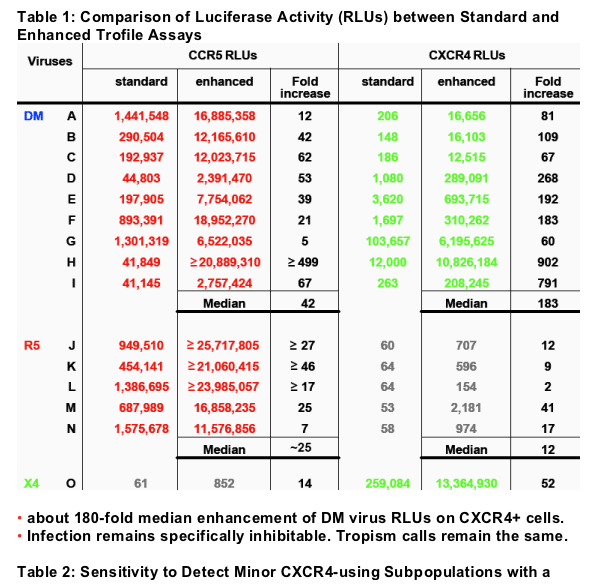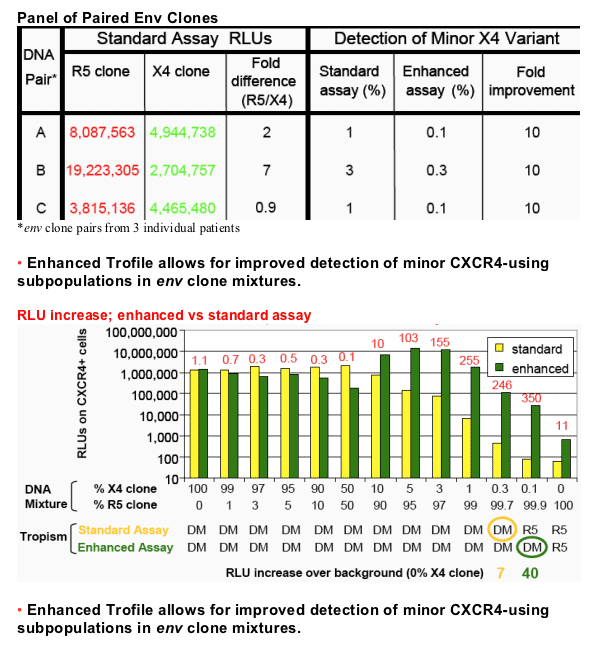 |
 |
 |
| |
Enhancements to the Trofile™ HIV Co-receptor Tropism Assay Enable Improved Detection of CXCR4-using Subpopulations
|
| |
| |
Reported by Jules Levin
ICAAC Sept 17-20, 2007, Chicago
BACKGROUND
- Maraviroc, a CCR5 antagonist, has recently been approved for the treatment of HIV patients with CCR5 tropic virus.
- Several entry inhibitors which block infection via CCR5 are in clinical development.
- The Trofile™ assay (Figure 1) is useful for selection and monitoring of patients receiving these inhibitors.
- In mixed envelope (env) populations, Trofile detects minor variants at 10% and 5% of the population with 100 and 83% sensitivity, respectively (levels below 5%
were not tested)(1). Minor variants below the detection limit of Trofile can sometimes be identified by clonal analysis (see Table 3) and may be selected following therapy with entry inhibitors targeting CCR5.
- We are exploring approaches to increase minor CXCR4-using variant detection in the event that this will further optimize selection of patients who may benefit from therapy with entry inhibitors targeting CCR5.
RESULTS
- Table 1. Trofile assay enhancements result in a median about 180 and about 40-fold increases in RLUs on CXCR4+ and CCR5+ cells, respectively, with a panel of DM Envs, while preserving high specificity for detection of R5 and X4 Envs.
- Figure 2 & Table 2. Using pre-defined mixtures of env clones with R5 or X4 tropism, the sensitivity for detection of X4 minor variants was increased 3-10-fold using the enhanced assay and ranged from 0.1 to 0.3%.
- Table 3. The enhanced Trofile assay allows for earlier detection of CXCR4-using Envs in a panel of longitudinal samples from patients with subsequent detection of CXCR4-using Envs in the standard assay. Earlier detection is supported by analysis of Env clones.
AUTHOR CONCLUSIONS
- The enhanced Trofile assay has been optimized to increase DM virus luciferase activity on CXCR4+ cells.
- Assay enhancements allow for improved detection of minor CXCR4-using subpopulations in env clone mixtures and earlier detection of minor CXCR4-using subpopulations in longitudinal samples from PR/RT inhibitor experienced patients.
- Assay enhancements can be modified to adjust assay sensitivity as required. Defining the level of sensitivity that is most clinically meaningful will entail retrospective evaluation of CCR5 inhibitor clinical trial samples with associated treatment outcome data.
METHODS
- R5, X4 and dual or mixed tropic (DM) env clones and patient env populations were used to assess Trofile sensitivity following assay modifications to determine if minor CXCR4-using variants could be detected with enhanced sensitivity.
- A broad range of modifications were designed and evaluated to maximize the luciferase signal, e.g. manipulation of virus input levels, cell (co)receptor levels, transfection and infection conditions.
- A combination of conditions designed to enhance DM virus infection on CXCR4+ cells, while maintaining infection specificity, were selected. RT-PCR
amplification and vector construction steps were not altered.


|
| |
|
 |
 |
|
|